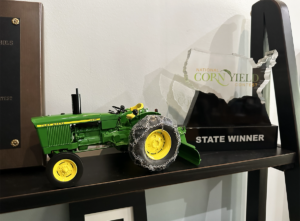This Week In Ag #120
Raising crops is a lot like raising kids. It’s a never-ending journey filled with plenty of joy, emotion, frustration and love. All marked with significant milestones. Here are the majors:
“They’re up!” Farming is driven by faith. Nothing requires more of it than placing a seed in the ground and hoping it emerges. That time between planting and emergence can seem like forever. Crop emergence is no guarantee. Even under the best of circumstances, 90% emergence is often considered good. But there’s no greater relief than seeing your crop rise above the ground. Emergence depends on several factors, including soil temperature, soil moisture and the crop itself. Most crops break through the surface in 1-2 weeks.
“You can ‘row it’.” This is when you drive down the road, look across your field, and see plants forming rows down the field. Now you’re off to the races! Back in the day, before GPS-guided steering systems, it also revealed how straight your rows were planted. That was the ultimate matter of pride among farmers.
“It’s hit canopy.” This is my corn’s current stage. Canopy occurs when the outstretched leaves from neighboring rows touch, effectively covering the area between the rows. This holds significant agronomic importance. For row-crop farmers, the goal is to get to canopy as soon as possible. Sure, row-crop farming is all about harvesting grains, oilseeds, and fiber at the end of the season. But during the season, farmers are harvesting sunlight. By canvassing your field with green solar panels, you optimize light interception and crop performance across the field. But crops aren’t the only plants that utilize sunlight. So do weeds. By shading the rows with a crop canopy, you deter weed growth. With corn, once the crop reaches canopy, and if the rows are fairly clean, the threat of weed competition is mitigated. That’s why many corn growers apply postemergence herbicides around the V5-V6 stage, when crops begin to canopy. Crops like soybeans take longer to canopy, which creates additional weed control and light utilization challenges. That’s why many growers opt to plant soybeans in narrow, 15” row spacings. My corn reached canopy in just 37 days, in wide 38” rows. That indicates rapid growth.
“Flower power.” Beyond their beauty, blooms signal reproduction. For soybean growers, the first time you pull back leaves and see purple or white blooms elicits a prideful grin. For fruit, nut and vegetable growers, blooms are often more obvious from afar, but no less exciting. Driving through the central valley of California, being surrounded by blooming almond trees, is a gorgeous sight for both farmers and onlookers.
“Tassel time.” My Aunt Marilyn always loved watching corn make tassels. Her house sat above a gradual slope overlooking a farm field. From her kitchen window, she could look down upon the field and see tassels pop up atop the corn plants. And with seven kids, frequent visits from her favorite nephew, and an always-hungry husband, she was in the kitchen a lot. The sight of corn tassels also prompts prayers for rain, as this is the most critical period in the crop’s life.
“The Lord’ll wait till pickin’ time.” That’s the ending line from a Johnny Cash song. I’ll forever remember how those words echoed throughout our house each fall from my dad and mom. You see, harvest is not just the time you get paid, it’s also when traditions and memories are made.
Related Posts

Let’s Talk Nutrients for a Minute
by Heather Jennings, PE Generally, in the wastewater industry we talk about 100 mg/L BOD to 5 mg/L Nitrogen to 1 mg/L Phosphorus. The values for nitrogen and phosphorus can be higher or lower than this, but it’s the average number that many wastewater system designs are built around. If you look a little further,

This Week in Ag #29
We all do it. We track time by referencing memorable items that we or our family once possessed. “Back when he drove that blue Silverado”, or “when she had that yellow Labrador” are examples of how we recall events that shaped our lives. For farmers, those points in time are often defined by a tractor.

This Week in Ag #19
Rain makes grain. Those words are as old as farming itself. In the nation’s breadbasket – the three I states, which produce 42% of our corn and 37% of our soybeans – there’s concern over the lack of rain. That triggered a major movement in the grain market. Drought officially grips 100% of the I

